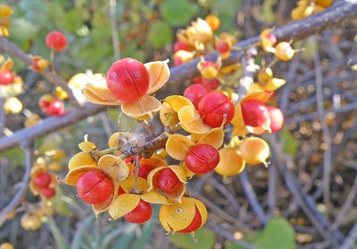|
November 7, 2018
November Weed of the Month: Local Solutions for Controlling Oriental Bittersweet
Emilie Justen, Minnesota Department of Agriculture
 In southeast Minnesota, an invasive woody vine has caused property damage and altered ecosystems with its prolific seed production and aggressive growth. Oriental bittersweet (Celatrus orbiculatus) was first confirmed in the Twin Cities Metropolitan Area in 2010, and has since been confirmed in multiple counties with the most severe infestations located in Red Wing and Winona. After the species was listed on the Minnesota Noxious Weed List Prohibited-Eradicate category in 2011, efforts initially were concentrated on mapping and developing management strategies to contain the spread. In 2013, the Minnesota Department of Agriculture (MDA) obtained funding from the Environment and Natural Resources Trust Fund as recommended by the Legislative-Citizens Commission on Minnesota’s Resources (LCCMR) to start an eradication program. The grant built the infrastructure in coordination with Conservation Corps Minnesota (CCM) and UMN Extension to work with landowners to manage infestations and provide outreach on identifying and learning management strategies.
|
In Winona, local efforts to control infestations of oriental bittersweet have been led by the county. Anne Morse, the Sustainability Coordinator and Assistant County Agricultural Inspector for Winona County, has organized workshops hosted on neighborhood residents’ property. Workshop participants learn how to identify and manage oriental bittersweet. Working neighborhood by neighborhood, Anne is empowering people to better manage invasive plants on their land. Building this community involvement is essential for long-term success. Morse was already connected with many community leaders and was able to recruit volunteers by pitching the project to teachers, outdoor recreation groups, civic groups, and networks of personal friends. Through these recruitment strategies, Morse assembled a group of committed individuals “who cherish and are passionate about recreating our blufflands.”
To engage landowners, Morse found a successful strategy by holding open houses in individual neighborhoods, which in Winona are wooded valleys within the extensive Mississippi river bluff landscape. Invitations were sent via mail to all landowners in each valley for “Root Beer and Bittersweet” events, which were held at the end of a workday. At the open houses, attendees learned about the eradication effort, were given a tour of nearby infested areas, and encouraged to sign up for an evaluation of their property.
Coordinated efforts between state and local partners has increased efficiency and maximized outcomes for bittersweet management. Morse said Winona County is “assiduous in documenting contacts and all property data of every landowner we speak with.” Winona County has “also invested in mapping the intensity of infestations on all the properties we have evaluated.” She also focuses on the volunteers and landowners, working “to make volunteer experiences as gratifying as possible, being sure to plan for needs, and being responsive.” The Winona Invasive Species Working Group has been meeting for several years to build connections, share knowledge, and strategize to allocate resources and move the eradication of oriental bittersweet forward.
Click here to download a photo.
Photo caption: Showy bright red fruit with yellow capsules of oriental bittersweet.
MEDIA: For more information on Weed of the Month, contact Allen Sommerfeld, MDA Communications, at allen.sommerfeld@state.mn.us or 651-201-6185
Having trouble viewing this email? View it as a Web page.
|